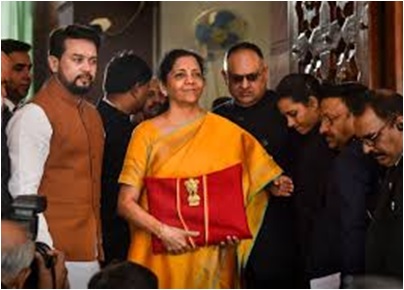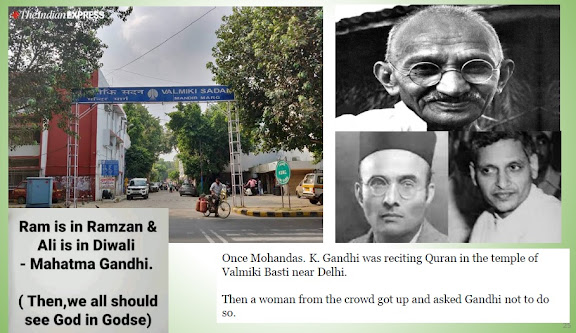ModiEconomics Budget 2020
The Budget Speech
delivered by Smt. Nirmala Sitharaman on the 1st February 2020 in the Lok Sabha was the longest
ever at 2 hours and 41 minutes and it is her second budget presentation. She is
also the second women to present the budget for a second time after Indira Gandhi.
She could not
complete her budget speech due to exhaustion.
It indicates that she should have restricted her speech but due her over
enthusiasm to touch all points had cost her this embarrassment. Though she
pleaded to complete her speech – stating that there were only two pages left,
she was advised not to stress too much both by Rajnath Singh, our Defence
Minister and then even by our Prime Minister who were seated next to her on the
front bench.
In January 2020 Nobel
Laureaates Abhijit Banerjee and Esther Duflo advised the
Government of India thus: The critical problem in the Indian economy is demand.
We should forget about Budget deficits and meeting targets. We should even
forget about inflation targeting. Let the economy rip a bit.
Perhaps Nirmala Seetharam seemed to have listened to them partially – as some time Experts on Economics
are too bookish, it will be politically unwise to implement their suggestions
in toto.
There were two options before the Government – Heavy Expenditure on infrastructure
or Social sector. Budget accepted both these options and had done a balancing
act without neglecting either of them or overplaying them.
$5 trillion economy goal by 2024 is Modi’s ambitious growth path for which this budget is aimed.
This budget is woven around three prominent themes:
One: Aspirational India in which all sections of the society seek better
standards of living, with access to health, education and better jobs.
Two: Economic development for all, indicated in the Prime
Minister’s exhortation of “Sabka Saath , Sabka Vikas , Sabka Vishwas”. This would entail reforms across
swathes of the economy. Simultaneously, it would mean yielding more space for
the private sector. Together, they would ensure higher productivity and greater
efficiency.
AND Three: a Caring Society that is both humane and
compassionate. Antyodaya is an article of faith.
These three broad themes are connected by governance that is corruption
free and a financial sector that is clean and sound.
To elaborate on these three themes, our Finance Minister had quoted a verse
in Kashmiri, Two Tamil Verses of Avvaiyar Athi Soodi and Valluvar Kural. She had also quoted a verse from Raghuvamsa of Kalidasa.
Kashmiri verse by Pandit Dinanath
Koul:Everything that we do, all of us do, is for this beautiful country.
Avvaiyar Aathisoodi verse 82: பூமி திருத்தி உண் - ஆத்திச்சூடி –
82
Meaning: Till the land and then eat.
Valluvar Thirukural – Verse 738:
பிணியின்மை செல்வம் விளைவின்பம் ஏமம்
அணியென்ப நாட்டிற்கு இவ் வைந்து.
Meaning: Freedom from illness, wealth,
produce, happiness and protection to subjects; these five, are the ornaments of
a king.
Verse 18, Sarga 1 Raghuvamsa by
Kalidasa:
प्रजानामेवभूत्यर्थंसताभ्योबलिमग्रहीत्।
सहस्रगुणमुत्स्रष्टुमादत्तेहिरसंरविः॥
Meaning: Surya, the Sun, collects
vapour from little drops of water. So does the King. They give back copiously.
They collect only for people’s well being.
Our Finance Minister had herself
become poetic and remarked about her budget as follows: “Ease of Living is a
bouquet wherein Aspirational India,
Economic Development and Caring India are the flowers. Holding this bouquet
together are two hands – one, Corruption free, policy-driven good
governance and two, clean and sound financial sector.”
Some Salient points spelt out in the
budget are here under:
v India imports
significant quantity of technical textiles worth US$ 16 billion every
year. To reverse this trend and to
position India as a global leader in Technical Textiles, a National Technical
Textiles Mission is proposed with a four-year implementation period from
2020-21 to 2023-24 at an estimated outlay of ` 1480 crore.
v The target is $5 billion
of defence export in next five years and to achieve the target, India
is building several defence equipment like artillery guns, aircraft
carriers, submarines, light-combat aircraft, and combat helicopters, he said.
"Our mantra is Make in India, for India, for world.” – This will earn
foreign exchange, employment and real boost to the sagging economy.
v A huge employment opportunity exists for
India’s youth in construction, operation and maintenance of infrastructure.
National Skill Development Agency will give special thrust to
infrastructure-focused skill development opportunities.
v About £ 1.70 lakh crore for transport
Infrastructure was provided.
v Major relief for income tax payers. Options to
choose the new income tax rates or the old income tax rates with deductions and
exemptions are made available which is also a new idea in the personal tax
regime.
v Currently more than one hundred exemptions and deductions of
different nature are provided in the Income-tax Act. In the
new simplified regime, around 70
of them are removed. Review and rationalisation of the remaining exemptions and deductions are to be
undertaken in the coming years with a view to
further simplifying the tax system and
lowering the tax rate.
v Huge non-tax revenue
of £ 2,10,000 crore is envisaged from disinvestment proceeds pertaining to Air
India and Bharat Petroleum apart from planned disinvestment of equity in the
Life Insurance Corporation of India (LIC) through IPO. Revenue from telecom
players are another item of non–tax revenue which is around £ 1,33,027 crore
and hence these non-tax revenue items – disinvestment plus telecom revenues
account for over 11%.
v Increase of insurance
cover on bank deposits from £ 1 lac to £ 5 lacs first step in 27 years give savers and investors a sense of security
more so in the context of bank frauds and defaults occurring more frequently.
v In September 2019 £
1,46,000 crore by way of lowering corporate tax rates – much to the
disappointment of individual tax payers- were given. Now by lowering income tax
rates, middle class is now happy – though this will entails loss of revenue to
the tune of £ 40,000 crore but giving money to individuals will boost the
consumer demands.
v Dividend Distribution
Tax is abolished, but individual share holders have to pay tax.
Capital Expenditure in 2019 was £10,338 lac crore but the same is
expected to rise by 18% over this figure in 2020-21 budget.
v Infrastructure: Kisan
Rail through PPP, more Tejas type trains to connect major tourist
destinations, delhi-mubai express way to
be completed by 2023 are a few items worth mentioning.
v 16 points agenda for
rural development are for doubling farmers’ income by 2022; some of the steps
outlined – solar pumps for farmers, warehousing and cold storage to water
sufficiency measures for over 100 water stressed districts – all august well
for the future. Solar energy to be generated from the fields of farmers, after
meeting their requirements, will be sold to the grid earning them a good
sizeable income.
v 16 ACTION points all
aligned to increase farm income will go a long way in increasing
empowerment opportunities in that
segment as well as help in creating avenues of giving more money in the hands
of the people.
v To boose start ups –
ESOP – Employee Stock Option tax – payment of tax on income earned from ESOP
deferred by five years or till employees leave the company or when they sell
their shares, whichever is earliest. This will be for only to start ups set up
post April 2016.
Education and skills development - Budget allocation of £ 99,300 for education in 2021 which includes £
3000 for skills development. This will encourage young educated force to set up
their own business centres to generate income, self exployment and more so
employments to others.
v Budget proposes to attach a medical college to
a dstrict hospital in public-private partnership model and this is to meet the
shortage of qualified medical doctors. Opening of more medical colleges are
also envisaged.
v 100 airports to be developed by 2025 for Udan
Scheme – 150 trains to be run under Public Private Partnership (PPP) Tejas type
trains for tourist destinations – large solar power capacity alongside rail
tracks.
Budget has rightly taken the provision
of slipping on the fiscal by 50 basis point to boost public spending to revive
the economic growth through rural agriculatural related economy, infrastructure
development and health sector related issues surrounding the economy. Under
Section 4 (2) of the Fiscal Act
Responsibility and Budget Management (FRBM) provides for a deviation
from the estimated fiscal deficit on account of structural reforms in the
economy with unanticipated fiscal implications.
Union budget has taken multiple
measures that will build the confidence of industry. This includes to reduce tax harassment, to
enhance contract enforcement, to decriminalize business laws and simply the the
processes of teax payment. This will improve business environment.
By this budget provisions, it is quite
evident that the growth pans were out in the economy in the next four quarters.
There is a quote:
Even if you are in the right track,
you will get run over if you move slowly.
The Finance Minister being well aware
of this quotable quote, had done her job exceedingly well and the Indian
Economy is not only put on the right track but also given sufficient impetus
and push for a fast growth and the ambitious target of $5 trillion economy for
India by 2024 is achievable.
Hindu editorial about Union Budget
2020-21 ends with this statement: Whether the budget flies or falls depends on
how growth pans out in the economy in the next four quarters.
“The Budget will fly and not fall”- is
the majority of the reviews of Business Pundits, Capital Market Experts,
Industrialists and even Economic Experts in the field.
E-Touch praises the Budget thus:
“Jai Ho! Nirmala Seetharaman! You had
created history not only by your lengthy budget speech, but also by asserting –
Indian Economy Fundamentals are strong and you had also further strengthened
the Fundamentals with extra doses of allocation of funds for $ 5 Trillion
Economy by 2024.
Link for Full text of budget speech:











Comments